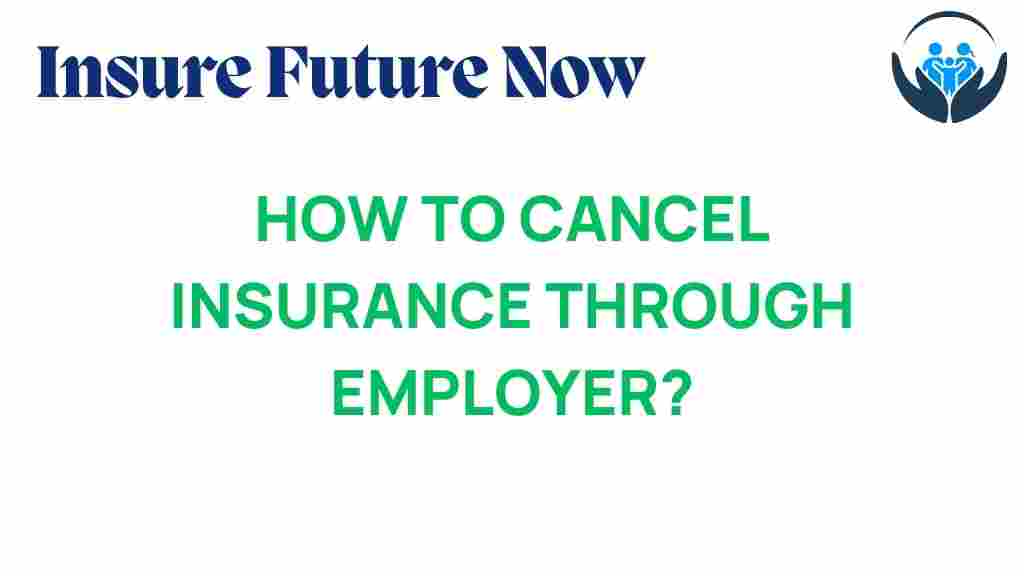In today’s fast-paced workplace, many employees rely on employer health plans as a primary source of health coverage. However, circumstances change, and you may find yourself in a position where you need to cancel insurance provided by your employer. Understanding the process and your options can help ensure you make the right decision for your health and financial needs. This article will guide you through the steps to cancel your insurance, the implications of doing so, and important aspects to consider.
Understanding Employer Health Plans
Employer health plans are part of the employee benefits package that many companies offer to attract and retain talent. These plans may include medical, dental, and vision insurance, as well as wellness programs. While these benefits are valuable, there are times when an employee may need to cancel their insurance due to various reasons, such as:
- Changing jobs
- Retirement
- Moving to a different state
- Finding a better insurance option
- Financial constraints
If you find yourself needing to cancel insurance, the process can vary depending on your employer’s policies. Understanding the termination process is essential to ensure you do not leave any gaps in your health coverage.
Step-by-Step Process to Cancel Insurance Through Your Employer
Here’s how to navigate the process of canceling your insurance:
Step 1: Review Your Employer’s Policies
Before making any decisions, review your employer’s workplace policies regarding health coverage. This information can often be found in the employee handbook or the benefits section of your company’s website. Look for:
- The timeline for cancellation
- Any required forms or documentation
- Potential penalties or fees for cancellation
- Other available insurance options
Step 2: Consult with HR
Once you have familiarized yourself with the policies, schedule a meeting with your HR representative. They can provide personalized information regarding your specific situation, including:
- How to formally cancel insurance
- Deadlines you need to be aware of
- Alternative health coverage options available
Step 3: Complete Required Documentation
After your consultation, you may be required to fill out specific forms to initiate the cancellation process. Ensure that you:
- Fill out all forms accurately
- Provide any necessary supporting documentation
- Keep copies of all submitted documents for your records
Step 4: Confirm Cancellation
Once you have submitted your cancellation request, it’s crucial to follow up to confirm that your insurance has been canceled. Ask HR for a confirmation letter or email that states your insurance coverage has been officially terminated. This will be important in case of any future insurance claims.
Step 5: Explore New Insurance Options
After canceling your employer-provided insurance, consider your next steps for health coverage. You may have several options, including:
- Purchasing an individual health plan through the marketplace
- Qualifying for government programs like Medicaid or Medicare
- Considering short-term health insurance plans
Research these options thoroughly to ensure you have adequate coverage that meets your healthcare needs.
Troubleshooting Tips
While the cancellation process can be straightforward, there may be complications. Here are some troubleshooting tips:
- Delayed Responses: If you do not receive timely responses from HR, follow up via email or phone.
- Incomplete Documentation: Ensure you have submitted all required paperwork. If you receive a notice of incomplete documentation, address it immediately.
- Understanding Your Rights: Familiarize yourself with your rights under the Consolidated Omnibus Budget Reconciliation Act (COBRA), which allows you to keep your insurance for a limited time after leaving a job.
Additional Considerations
When deciding to cancel insurance, consider the following:
- Timing: Make sure you understand the timing of your cancellation in relation to your employment status.
- Continuation of Benefits: If you are eligible for COBRA, you may want to consider this option temporarily to avoid gaps in coverage.
- Impact on Dependents: If you have dependents covered under your plan, think about how their health coverage will be affected.
For more detailed information about employee benefits and health insurance options, you can visit the Healthcare.gov website.
Conclusion
Canceling insurance through your employer may seem daunting, but with a clear understanding of the process, you can navigate it effectively. By reviewing workplace policies, consulting with HR, and completing the necessary paperwork, you can ensure a smooth transition away from your employer health plans. Remember to explore your new insurance options to maintain continuous health coverage and avoid any gaps that could affect your healthcare needs. Always stay informed about your rights and consider seeking advice if you encounter challenges during the cancellation process.
For additional resources and support, you may find it helpful to connect with local insurance agents or healthcare navigators who can assist you in finding the best coverage options suited for your needs.
This article is in the category Policies and created by InsureFutureNow Team
